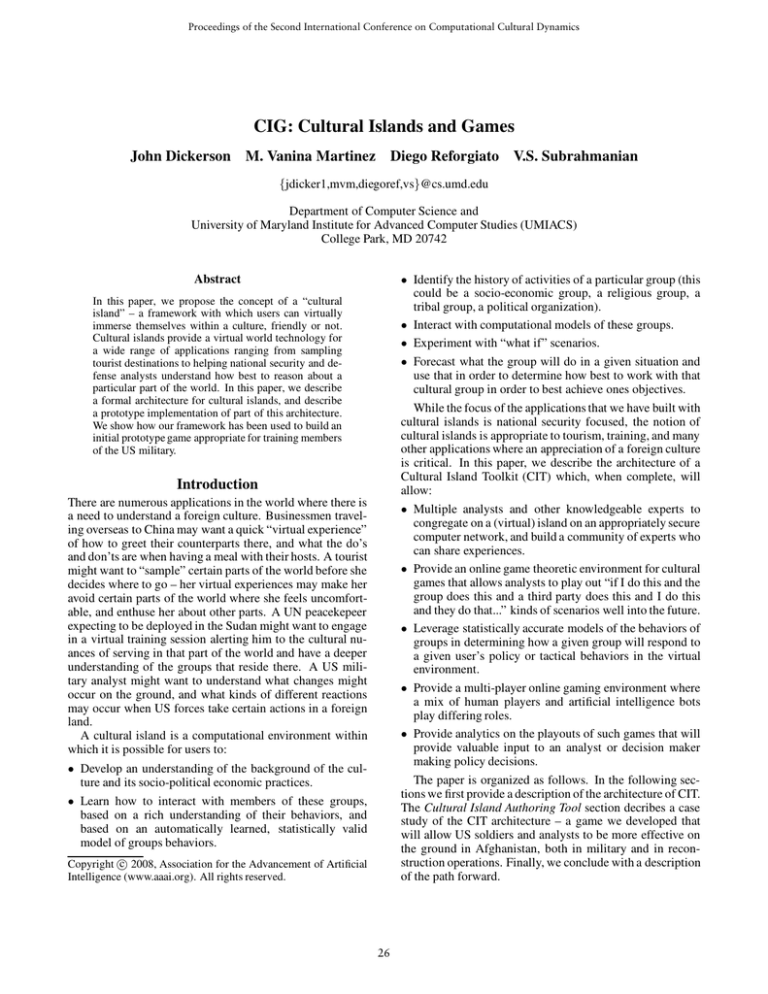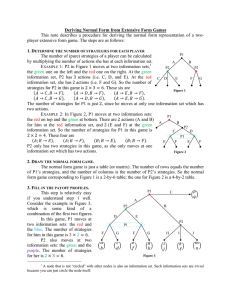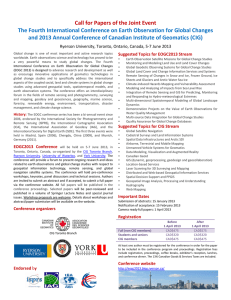
Proceedings of the Second International Conference on Computational Cultural Dynamics
CIG: Cultural Islands and Games
John Dickerson M. Vanina Martinez Diego Reforgiato V.S. Subrahmanian
{jdicker1,mvm,diegoref,vs}@cs.umd.edu
Department of Computer Science and
University of Maryland Institute for Advanced Computer Studies (UMIACS)
College Park, MD 20742
Abstract
• Identify the history of activities of a particular group (this
could be a socio-economic group, a religious group, a
tribal group, a political organization).
• Interact with computational models of these groups.
• Experiment with “what if” scenarios.
• Forecast what the group will do in a given situation and
use that in order to determine how best to work with that
cultural group in order to best achieve ones objectives.
While the focus of the applications that we have built with
cultural islands is national security focused, the notion of
cultural islands is appropriate to tourism, training, and many
other applications where an appreciation of a foreign culture
is critical. In this paper, we describe the architecture of a
Cultural Island Toolkit (CIT) which, when complete, will
allow:
In this paper, we propose the concept of a “cultural
island” – a framework with which users can virtually
immerse themselves within a culture, friendly or not.
Cultural islands provide a virtual world technology for
a wide range of applications ranging from sampling
tourist destinations to helping national security and defense analysts understand how best to reason about a
particular part of the world. In this paper, we describe
a formal architecture for cultural islands, and describe
a prototype implementation of part of this architecture.
We show how our framework has been used to build an
initial prototype game appropriate for training members
of the US military.
Introduction
There are numerous applications in the world where there is
a need to understand a foreign culture. Businessmen traveling overseas to China may want a quick “virtual experience”
of how to greet their counterparts there, and what the do’s
and don’ts are when having a meal with their hosts. A tourist
might want to “sample” certain parts of the world before she
decides where to go – her virtual experiences may make her
avoid certain parts of the world where she feels uncomfortable, and enthuse her about other parts. A UN peacekepeer
expecting to be deployed in the Sudan might want to engage
in a virtual training session alerting him to the cultural nuances of serving in that part of the world and have a deeper
understanding of the groups that reside there. A US military analyst might want to understand what changes might
occur on the ground, and what kinds of different reactions
may occur when US forces take certain actions in a foreign
land.
A cultural island is a computational environment within
which it is possible for users to:
• Multiple analysts and other knowledgeable experts to
congregate on a (virtual) island on an appropriately secure
computer network, and build a community of experts who
can share experiences.
• Provide an online game theoretic environment for cultural
games that allows analysts to play out “if I do this and the
group does this and a third party does this and I do this
and they do that...” kinds of scenarios well into the future.
• Leverage statistically accurate models of the behaviors of
groups in determining how a given group will respond to
a given user’s policy or tactical behaviors in the virtual
environment.
• Provide a multi-player online gaming environment where
a mix of human players and artificial intelligence bots
play differing roles.
• Provide analytics on the playouts of such games that will
provide valuable input to an analyst or decision maker
making policy decisions.
The paper is organized as follows. In the following sections we first provide a description of the architecture of CIT.
The Cultural Island Authoring Tool section decribes a case
study of the CIT architecture – a game we developed that
will allow US soldiers and analysts to be more effective on
the ground in Afghanistan, both in military and in reconstruction operations. Finally, we conclude with a description
of the path forward.
• Develop an understanding of the background of the culture and its socio-political economic practices.
• Learn how to interact with members of these groups,
based on a rich understanding of their behaviors, and
based on an automatically learned, statistically valid
model of groups behaviors.
c 2008, Association for the Advancement of Artificial
Copyright Intelligence (www.aaai.org). All rights reserved.
26
taken by the group during the year (e.g., kidnappings, armed
attacks, transational attacks on governmental security apparatus, etc.)
The SOMA Extraction Engine automatically extracts
rules of the form: “if some condition C is true over the environmental variables, then the group in question will execute action A with a probability of L to U %.” To date, the
SOMA Extraction Engine has extracted rules on about 36
groups ranging from Morocco in the west to Afghanistan
in the east. These stochastic rules constitute the behavioral
model library used by our Cultural Island Toolkit.
The heart of this paper focuses on the computational environment that allows analysts to use a multi-player game
oriented framework in order to interact with each other, with
the computational realization of the extraction SOMA models, and with the environment.
Note that, to date, we have not fully implemented the CIT
architecture. The design of the architecture is complete, and
this is what we describe in the paper. Those parts that still
need to be implemented will be clearly specified.
The CIT Architecture
Figure 1 below presents a detailed view of the CIT architecture. Boxes shown in black are still to be built. Boxes shown
in gray are done, while boxes shown in white are at some
intermediate stage of completion. The CIT architecture supports an end to end, real time operation, starting with the
ingestion of data in real time, the construction of behavioral
models of the groups in a particular part of the world, and
the actual game environment itself that uses these as inputs
in order to support the user’s play.
Cultural Island Authoring Tool
The Cultural Island Authoring Tool allows users to author
a cultural island game. We assume the existence of a set S
of game states that is somehow implicitly defined. We have
developed an initial game called CAVE (Cultural Afghan
Village Environment) which is intended as a mechanism to
help US soldiers enter an Afghan village. In CAVE, there is
one US soldier interested in entering an Afghan village and
several villagers that he encounters during his visit. Each
villager has an initial tendency to support Americans (or
this American in particular). This tendency ranges from −1
(completely against) to +1 (completely for). Each vector
of the form hs1 , s2, ..., sni where si denotes the tendency of
the i-th Afghan villager towards the US soldier forms part
of the state of the game. This is called the cultural compatibility index vector (CCIN for short).
However, the game state also consists of other parts. One
key part is a video clip corresponding to video content to
be shown as part of a given node. Another component of a
game state consists of a question and a set of possible answers to that question.
Thus, a CIG game is characterized by three components:
• A set C of CCIN vectors specified either implicitly or explicitly.
• A set Q of questions expressed in English and for each
question q in Q, a set ANS (q) of possible answers (also
in English).
• A set V of video clips (in our CIG implementation, these
video clips were recorded using the Second Life environment (Linden Research, Inc 2003)).
A cultural island game G based on (C, Q, V ) is a tree
where:
• Each node in G is labeled with a triple (c, q, ANS(q))
where c is in C, q is in Q, and Ans(q) is the set of all
answers to q.
• If N is a node labeled with (c, q, ANS(q)), then N has
one child node associated with each answer in Ans(q).
Thus, a CIG game is represented as a tree. Each node in
the tree represents a game state consisting of a cultural compatibility index vector, a question, and the (deterministic) set
Figure 1: Architecture of the Cultural Island Toolkit
The cultural island architecture takes data sources (both
legacy sources and real time sources) and feeds them directly into any game that is built using the toolkit. These
data sources are analyzed using text analytic programs such
as the OASYS Opinion Analysis System (Cesarano et al.
2006) and The RDF EXtractor (T-REX for short) (Albanese
and Subrahmanian 2007) which automatically extracts information of interest from the live data sources. Currently,
T-REX and OASYS both track news and blog sources; also,
T-REX tracks some social media sources such as a small
amount of YouTube comments (not the raw video).
In addition, the Minorities at Risk data set was created
through extensive manual analysis of data by political scientists. For each of 117 ethnopolitical groups at risk of
falling into terrorism, this data set contains information on
about 150 variables, coded on an annual basis. Thus information about each of these ethnopolitical groups is represented as a table. Each row in the table represents a year
(up to 25 years), and each column represents a variable. The
variables fall into two categories: environmental variables
describing the environment in which the group functioned
in a given year (including information on actions taken by
other players that might affect the group being modeled) and
action variables that describe various inappropriate actions
27
Figure 2: CIG Authoring Tool Screenshot
Figure 3: Screenshot when a set of answers to a question is provided
by specifying the question to be asked (both textually and/or
via a recorded audio clip), the movie file to be shown, the answer, the cultural compatibility index, as well as translations
of the answer (if they are given in a foreign language).
Figure 3 shows the situation when the user has a question
with two possible answers. One node is created for each
possible answer and the user can fill in the appropriate state
information.
The author of a CIG game can easily instantiate the fields
shown in the figure. The structure of the tree describing the
game can also be easily visualized by the user as shown in
Figure 4 below.
of answers to the question. Depending on which answer the
user selects, a new node is chosen.
As SOMA rules are stochastic, we do have plans to allow
the answer to a question to cause a non-deterministic (probabilistic) transition to a child state. However, we have not
incorporated this into the CIG design thus far.
The Cultural Island Authoring Tool is a password protected online tool for authoring such CIG games. A user can
use this tool to:
• Specify the content of a node.
• Specify what video is associated with a node.
• Specify the question and set of answers to that question
associated with the node.
• Specify what the children of the node are.
Thus, the author of a CIG game can generate these nodes
in a tree with very little knowledge of computer science.
This is important as it allows graphic artists, policy experts,
and others to come together around a CIG game in order to
best orchestrate the game. Figures 2, 3, and 4 show screenshots of the CIG Authoring Tool.
The reader can see from Figure 2 above that the user can
add a node and that this node causes various fields within
the node to be generated. The user can instantiate a node
Cultural Island Execute Tool
The Cultural Island Execute Tool is focused on providing
the execution environment for a game authored within the
CIG environment. The current implementation of the Cultural Island Execution Tool distributes the game produced in
Section above as a single player game available on a DVD.
However, we have done some work on the design of a
multi-player version of CIG that will be accessible online. In
the multi-player version of CIG, there is a central database
called GameDB that tracks the game state at any given point
in time.
28
CAVE: Cultural Afghan Village Experience
Game
Based on the principles articulated in the preceding sections,
we have developed a game focused on supporting US soldiers who are entering an Afghan village. The aim of the
game is for the soldiers to be culturally sensitive and make a
good impression on the Afghan villagers. Players do well in
the game if the Afghan villagers feel the players respect and
understand them and their culture, are reliable partners who
care about them and are likely to assist them in the improvement of their lives.
Figure 5: Game trees for two players P1 and P2
Figure 4: Structure of the CIG tree
A multiagent game state associates a cultural compatibility index with each player in the game. Thus, if a villager
(played by a bot in the game) is confronted with three players, all representing the US military, he will have a cultural
compatibility index for each of them which may vary from
one US player to another. We let CCIN (i, j) denote the
cultural compatibility index of bot i towards human player
j. Thus, each player P has an associated vector CCIN (P )
containing a vector of CCINs that the different bots in the
game hold toward him.
Let us suppose that we have a single agent game G(P )
associated with each player P having the form described
earlier in this paper. A multiagent CIG game is also a tree
where:
Figure 6: Combined game tree when P1 and P2 play at the
same time
The definition of multiagent CIG game makes it possible
for players to join a game after another player has already
started playing. Figure 7 shows what the multiagent game
tree looks like in the above example when Player P2 joins
the game one unit of time after player P1 started playing.
• Each node MN is a partial mapping from players (or
player’s ids) to triples of the form (c, q, ANS(q)) and
• If (c(P ), q(P ), ANS(q(P ))) is a child of the node labeled
(c, q, ANS(q)) in G(P ), then there is a child MN 0 of MN
such that MN 0(P ) is (c(P ), q(P )ANS(q(P ))).
In other words, a multiagent CIG game has nodes that
combine nodes from single player CIG games. Figure 5
shows a simple example where there are two players. Figure 5a) shows the game for Player P1 , while Figure 5b)
shows the tree for Player P2. Figure 6 shows the combined multiagent CIG game tree when Players P1 and P2
start playing at the same time.
As a consequence, we can see that it is possible to automatically merge the trees of individual games when they
start to form a multiplayer game.
Figure 7: Merged game tree when player P2 joins the game
a unit of time after player P1
The CAVE game itself has three levels. The first level is
a basic introductory level where a soldier drives up to a vil-
29
lage, introduces himself to the villagers, and asks to meet
the elders. The level goes all the way from the vehicular
approach to the village, to the initial greetings from the villagers, to meetings in the village Shura room with village
elders, to the soldiers departure in this vehicle.
The second level is reached only if the soldier achieved a
passing score on the first level. This level focuses on social
welfare of the village including understanding how best the
soldier might help achieve better health care, educational,
and reconstruction goals. A significant part of this level focuses on the conversation within the Shura room with village
elders.
Finally, the third level focuses on how the soldier might
enlist the villagers in helping gather information that could
save lives of both villagers and US personnel. The idea is
to determine if there are terrorists hiding in the village, or
whether there are roadside bombs planted near the village,
and how terrorists may use the village in furthering their
goals. In total, CAVE consists of about 3800 nodes.
Figures 8 shows a screenshot of the US soldier entering
the village. Players who play the game get a score at the end
of each level. Figure 10 shows one such sample screenshot.
Figure 9: Screenshot of the US soldier meeting village elders inside the village Shura room.
Figure 10: Screenshot of user’s score after completing the
first level
Figure 8: Screenshot of US soldier entering the village
• Adobe’s Flash CS3 – provides animated main menu,
load/save games from XML files – contains around 500
lines of ActionScript 2.0.
Figure 9, on the other hand, shows a screenshot of the US
soldier engaged in a discussion with village elders inside the
Shura room.
In conjunction with the software suites mentioned above,
other readily available tools were used. These include:
Implementation Details
The CAVE Game is a Windows-specific application developed primarily on commercially available software using
well-documented programming languages. The majority of
the development time was spent in three environments:
• Linden Lab’s Second Life – provides gameplay visualizations of soldier interacting with villagers in a virtual
Afghan village – contains around 500 lines of Linden
Script Language.
• Macromedia’s Director MX 2004 – provides user-run options, ties game structure (an XML file) with the Second
Life visualizations – contains around 3000 lines of Lingo.
• Autodesk’s 3d Studio Max – created models and respective animations for importing into the Afghan village environment in Second Life – employed around 300 lines of
MaxScript.
• Adobe’s Photoshop CS3 – created textures for the Second
Life models as well as the logos and cover art.
• Adobe’s After Effects CS3 – edited videos and added subtitle capability.
• Adobe’s Dreamweaver CS3 – used to help edit the nearly
4,000 nodes describing the CAVE game.
30
• Ruby programming language – used around 700 lines of
scripts to automate various tasks.
The game itself runs on any somewhat modern laptop or
desktop that runs the Windows operating system. It does not
require any specialized hardware beyond a pair of speakers
and a mouse. A full installation requires about 1.5 GB of
space, while the game itself easily fits onto a standard DVD.
ceedings of the 1999 ACM SIGMOD international conference on Management of data, 121–132. New York, NY,
USA: ACM.
Albanese, M., and Subrahmanian, V. 2007. T-rex: A system for automated cultural information extraction. First
International Conference on Computational Cultural Dynamics.
Buchanan, M. C., and Zellweger, P. T. 1993. Automatically
generating consistent schedules for multimedia documents.
1(2):55–67.
Candan, K. S.; Lemar, E.; and Subrahmanian, V. S. 2000.
View management in multimedia databases. The VLDB
Journal 9(2):131–153.
Candan, K. S.; Prabhakaran, B.; and Subrahmanian, V. S.
1996. Chimp: a framework for supporting distributed multimedia document authoring and presentation. In MULTIMEDIA ’96: Proceedings of the fourth ACM international
conference on Multimedia, 329–340. New York, NY, USA:
ACM.
Cesarano, C.; Dorr., B.; Picariello, A.; Reforgiato, D.;
Sagoff, A.; and Subrahmanian, V. 2006. Opinion analysis
in document databases. Proc. 2006 AAAI Spring Symposium on Computational Approaches to Analyzing Weblogs,
Stanford, CA.
Khuller, S.; Martinez, M. V.; Nau, D.; Simari, G.; Sliva,
A.; and Subrahmanian, V. 2007. Computing most probable worlds of action probabilistic logic programs: scalable
estimation for 1030,000 worlds. Annals of Mathematics and
Artificial Intelligence 51(2):295–331.
Linden Research, Inc. 2003. Second Life, Official Site of
the 3D Online Virtual World: http://www.secondlife.com/.
Little, T., and Ghafoor, A. Apr 1990. Synchronization and
storage models for multimedia objects. Selected Areas in
Communications, IEEE Journal on 8(3):413–427.
Subrahmanian, V.; Albanese, M.; Martinez, V.; Reforgiato,
D.; Simari, G. I.; Sliva, A.; Udrea, O.; and Wilkenfeld, J.
2007. CARA: A Cultural Reasoning Architecture. IEEE
Intelligent Systems 22(2):12–16.
Related Work and Conclusions
We are not aware of any work on building cultural games.
There is, of course, a rich history of work on gaming in general and multimedia presentations (of which genre this work
forms one important part).
CIG is based on our prior work on multimedia presentations (Candan, Lemar, and Subrahmanian 2000; Candan,
Prabhakaran, and Subrahmanian 1996) in which one of the
authors defined the concept of a multimedia presentation
and an interactive multimedia presentation as a tree. Prior
work (Buchanan and Zellweger 1993; Little and Ghafoor
Apr 1990; Adali, Sapino, and Subrahmanian 1999) had focused on non-interactive multimedia presentations and had
focused on important issues such as delivery across a computed network. CIG builds on these efforts by explicitly focusing on the states contained within these games, and on
building a platform within which such cultural games can
be constructed. In addition, CIG brings together the important idea of a multiagent game not found in these previous
works. Importantly, CIG games have video components that
we have prototyped within Second Life.
More importantly, CIG is being designed to eventually
build on top of live news and blog feeds that will dynamically change the game state and will support the use of real
models of behaviors of real cultural groups and/or terror
groups as described in the CARA cultural modeling architecture (Subrahmanian et al. 2007; Khuller et al. 2007). Our
system already contains automatically extracted rules for 36
terrorist groups from Morocco to Afghanistan.
Several important questions remain open. How easy is it
to construct cultural games using CIG? How useful are these
cultural games in helping policy makers arrive at decisions?
What additional features must be present in CIG to better
support such needs? These and other questions are the topic
of our ongoing research efforts.
Acknowledgements
The authors gratefully acknowledge funding support for this
work provided by the Air Force Office of Scientific Research through the Laboratory for Computational Cultural
Dynamics (LCCD) and AFOSR grants FA95500610405 and
FA95500510298, the Army Research Office under grant
DAAD190310202, and the National Science Foundation under grant 0540216. Any opinions, findings, or recommendations in this document are those of the authors and do not
necessarily reflect the views of sponsors.
References
Adali, S.; Sapino, M. L.; and Subrahmanian, V. S. 1999.
A multimedia presentation algebra. In SIGMOD ’99: Pro-
31
ICCCD 2008
Proceedings
This paper was published in the Proceedings of the Second International Conference on
Computational Cultural Dynamics, edited by V. S. Subrahmanian and Arie Kruglanski
(Menlo Park, California: AAAI Press).
The 2008 ICCCD conference was held at the University of Maryland, College Park,
Maryland, USA, 15–16 September, 2008.








